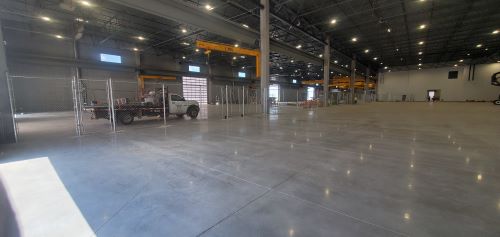When most people think about industrial fencing, they probably think about fencing outside of buildings. But we see huge demand for industrial interior fencing, like this project that was recently completed by our Rite-Way Fencing team in Red Deer. So we thought it was a good idea to look at interior industrial fence in a little more detail.
Ideal Winter Project
The first thing that you should know about interior industrialf fencing is that it's the ideal project for winter in Canada. Not only are fence crews available (whereas in summer, they're moving from one outdoor site to another as soon as one job finishes) but warehouses and factories tend to be a little quieter too. This makes it easier to give our crews the space they need to install the fence you need.
Why Install an Industrial Interior Fence?
The next thing you probably need to think about is why you might want to install an industrial interior fence. There are actually several reasons you might want to do this, such as:
Safety is a big reason to install industrial interior fencing. Designating pedestrian areas from places where equipment like forklifts will operate, or separating machines from general use areas is a great idea, and might improve your safety program dramatically. If you have mixed use areas for staff, the public and other users with different safety clearances, this might also be a consideration.
Differentiation between different areas is another big reason people choose to install industrial interior fence. When you have several different departments or work groups using a single space, there can be some space issues, where one type of work spills over into an area designated for another. Putting physical barriers like fences between your work groups or departments allows for clear sight lines and no changes to ventilation and other services, but makes it a lot harder for one group to encroach on the space of another.
Security is another big reason to install industrial interior fencing. Not only can a good fence keep unauthorized people out of restricted areas, but additions like privacy slats can even protect sensitive areas from view. Or you might choose to install a product like "mini mesh" that has mesh apertures too small to pass even small components through.
There are many individual reasons why you might want to install an industrial interior fence, but they're all designed to improve producitivity, increase security and make workspaces safer for the people who use them.
Types of Industrial Interior Fence
There are many different types of industrial interior fence, and many are custom designed to suit the space.
You can choose to have a woven product like chain link fence installed inside a building, or something more rigid like a panel fence. Or, like some customers do, you might choose a combination of more than one type of fence in different areas.
There are also a huge variety of gates available for your interior fence project. We can design, manufacture, supply and install single gates, panic gates, articulated gates, rolling gates and cantilever gates. We can even automate some kinds of gates, and there are custom track and hardware options available, if you need something specific. You could even integrate your gates with your security system by using magnetic locks or gate access control systems.
How We Design, Manufacture and Install Interior Fences
Interior fences, particularly in industrial settings, are a little different to the standard fences you will see installed outside most buildings.
In some cases, industrial partition fences are considerably higher than most outside fences. Some are even attached to the top and bottom of the building. This means they need to be quite a lot beefier than your standard fence system.
Attaching your fence to an existing concrete floor is another change to interior fences. We will need to manufacture your fence posts with base plates welded to the bottom of each fence post. These are usually fastened to your floor using wedge anchors, but in some cases, where a heavier fence is being installed, chemical anchors can be used instead.
When you are planning an interior industrial fence, it's a good idea to provide us with blueprints for the space, marked where you hope to install your fence, and to arrange a site visit with a Rite-Way Fencing staff member. That's because features that might not be shown on plans (like lighting, overhead cranes, ducting and other features might affect the fencing.
It's also a good idea to make sure your facility will still comply with legislation like fire codes and similar. In some cases, restricting flow to things like emergency exits could get you into trouble.
Ready to Design Your Interior Industrial Fence
Rite-Way Fencing branches in Alberta, British Columbia, Saskatchewan and Ontario regularly install partition fences and other interior industrial fences for our clients. If you're just starting the process of designing this type of fence, whether for yourself or a client of yours, we're always happy to help. Contact us to find out more about your interior fence options, materials and more.
Interesting? Share it!






